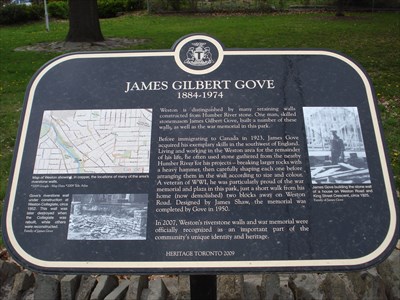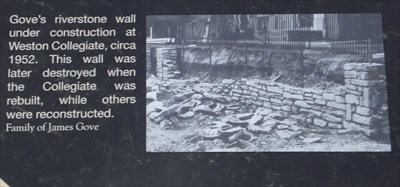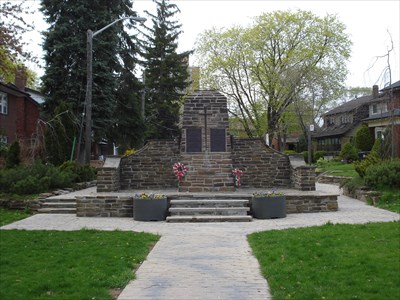
James Gilbert Gove
1884 - 1974
Weston is distinguised by many retaining walls constructed from Humber River stone. One man, skilled stonemason James Gilbert Gove, built a number of these walls, as well as the war memorial in this park.
Before immigrating to Canada in 1923, James Gove acquired his examplary skills in the southwest of England. Living and working in the Weston area for the remainder of his life, he often used stone gathered from nearby Humber River for his projects - breaking larger rocks with a heavy hammer, then carefully shaping each one before arranging them in the wall according to size and colour.
A veteran of WWI, he was particularly proud of the war memorial and plaza in this park, just a short walk from his home (now demolished) two blocks away on Weston Road. Designed by James Shaw, the memorial was completed by Gove in 1950.
In 2007, Weston's riverstone walls and war memorial were officially recognized as an important part of the community's unique identity and heritage.
Heritage Toronto 2009


THE STORY OF JAMES GILBERT GOVE
Building stone walls like the ones we have in Weston was a time consuming, meticulous and physically demanding job. No one knows who built all of them but we do know that master stone mason James Gilbert Gove spent almost forty years in Weston creating a great many of them.
James Gove was born on December 20, 1884 in the village of Holcombe Burnell, Devon, in the southwest of England. As a young man, he apprenticed as a stonemason and when his training was complete, he began working in the building trades in Devon and neighbouring shires.
During World War I, Gove served in the 505th field company of Royal Engineers. His unit shipped out at Christmas 1916 and once in France, was sent to engage in some of the bloodiest fighting of the war, including clashes at Passchendaele and the Allied assaults on the Hindenburg Line. For his service, Gove was awarded both the British War Medal and Victory Medal. He returned to England in March 1919.
After the war, with a wife and three children to support, Gove decided to move to Canada to seek employment and a better life for his family. He departed England in April 1924, arriving at the port of Halifax and shortly thereafter, made his way to Weston. His wife, Ida, and his family followed thirteen months later. By the time their fourth child was born, in 1929, they were living in a lovely home at 152 North Main Street (later renumbered 2104 Weston Road) near the corner of Fern Avenue. Gove immediately became active in the community, joining the Royal Canadian Legion and Sons of England Fraternal and Benefit Society.
During this time, Gove began to plan and construct numerous river stone walls for neighbouring properties and for the municipality of Weston. These walls were made from brown siltstone brought up from the Humber River and were distinctively designed, similar to walls in Devon and Somerset, capped with upright narrow stones and often held in place by short flanking pillars. Gove was responsible for many walls fronting Weston Road, Fern Avenue and Lawrence Avenue, as well as those along King Street Crescent and Little Avenue.

In September of 1949 there appeared in the Times and Guide an artist’s conception of the proposed new war cenotaph that the town council had decided to build. It was to replace the old memorial that was “variously described as unattractive, neglected and broken down”. Designed by Mr. James Shaw, “the actual stone work in dismantling of the cairn and erection of the new memorial was carried out by a well-known Weston resident, Mr. James Gove... The completed memorial is something of which all Weston citizens must be very proud of and to the creator and constructor must go the great satisfaction of a job well done.”
The plaque and stone from the original cairn were embedded in the construction of the new memorial.
Gove completed this labour of love in time for its dedication to the community on October 5, 1950. Hundreds of people came out to the unveiling. The cenotaph still stands today as a memorial to the people who gave their lives in both World Wars but also as a tribute to the man who put his heart and soul into his work.
James Gove worked as a stone mason for the rest of his working life in and around Weston. As late as 1951, the Town Council minutes state “that the Parks Committee is hereby authorized to engage Mr. James Gove to erect a stone fence adjoining the south boundary of the Town Hall Park at an approximate cost of $400.00."
Information taken from: Visit website